I recently posted a question about changing the spindle height on a (used) 2436. That question has been answered, so my next question, as I perform my due diligence is, what's the slowest speed that the lathe will run at for about 30 minutes? I often apply a polyurethane finish on my HFs via the method described by Steve Sinner; poly put on with lathe turning slowly and left turning at the slow speed for about 30 minutes. My current lathe's lowest speed is 60 rpm, which is ok, but I would run it slower if I could. Anyone have experience running a 2436 at a slow speed, and what is that speed? Thanks.
-
November 2025 Turning Challenge: Wall Hanging! (click here for details) -
Congratulations to Craig Morton, People's Choice in the October 2025 Turning Challenge (click here for details) -
Congratulations to Andy Chen for "Mesquite Vase with Polymer Clay Millefiori" being selected as Turning of the Week for November 3, 2025 (click here for details) -
Welcome new registering member. Your username must be your real First and Last name (for example: John Doe). "Screen names" and "handles" are not allowed and your registration will be deleted if you don't use your real name. Also, do not use all caps nor all lower case.
You are using an out of date browser. It may not display this or other websites correctly.
You should upgrade or use an alternative browser.
You should upgrade or use an alternative browser.
OneWay 2436 Low Speed
- Thread starter Ed Weingarden
- Start date
Ed, does Oneway's website give that info?
I think it is 50rpm on my little 1224, but that's a different setup than the 2436.
I think it is 50rpm on my little 1224, but that's a different setup than the 2436.
Don't know about the Oneway, but I knew a guy who made a slow turner device just for finishes. I don't remember the details but rotisserie motor/kit for a grill might work. Another thing that might work is mount a small pulley on the lathe and a build something that could rotate a chuck, driven by a belt to a larger pulley.
Oh, I just did a search and found this thread with several ideas. I like the one that uses an old treadmill motor to turn the lathe spindle.
-----------------------------------------------------------------------------------------------------------------------------------------------------------
-----------------------------------------------------------------------------------------------------------------------------------------------------------
JKJ
Oh, I just did a search and found this thread with several ideas. I like the one that uses an old treadmill motor to turn the lathe spindle.
-----------------------------------------------------------------------------------------------------------------------------------------------------------
I'm looking to upgrade my lathe but can shave nearly $1000 off the purchase price by buying a lathe (Record Envoy) that has a higher minimum speed that I'd like (250 rpm).
I can do this if I can build some kind of finishing machine/jig that will hold a chuck or faceplate and turn slow enough to allow a finish to dry without drips. There are two options that I can think of -- either turning the chuck or handwheel on the lathe, as TheHornedlizardman1 demonstrates here:
Youtube:
View: https://www.youtube.com/watch?v=488QK8aHkKU
or, preferably, a...
I can do this if I can build some kind of finishing machine/jig that will hold a chuck or faceplate and turn slow enough to allow a finish to dry without drips. There are two options that I can think of -- either turning the chuck or handwheel on the lathe, as TheHornedlizardman1 demonstrates here:
Youtube:
or, preferably, a...
- Everett Vander Horst
- finishing jig slow-speed
- Replies: 13
- Forum: Woodturning Discussion Forum
-----------------------------------------------------------------------------------------------------------------------------------------------------------
JKJ
The Oneway site shows that each of the three ranges start at zero. I don't know if that means it could run at 5 rpm, or some other minimum rpm.Ed, does Oneway's website give that info?
With no load, I don't think these motors would overheat or anything. Whatever it will turn down to that works for you.
Personally I would bo with the slow speed finish machine compared to tying up that expensive machine. They even selll them on Amazon now. https://www.amazon.com/Resiners-Mac...c6-8642-9f2e5cbbedfe&pd_rd_i=B0BG7MSHPN&psc=1I recently posted a question about changing the spindle height on a (used) 2436. That question has been answered, so my next question, as I perform my due diligence is, what's the slowest speed that the lathe will run at for about 30 minutes? I often apply a polyurethane finish on my HFs via the method described by Steve Sinner; poly put on with lathe turning slowly and left turning at the slow speed for about 30 minutes. My current lathe's lowest speed is 60 rpm, which is ok, but I would run it slower if I could. Anyone have experience running a 2436 at a slow speed, and what is that speed? Thanks.
Kevin Jesequel
TOTW Team
It goes to zero, so you could run it at any speed. If you’re concerned about overheating, you can position a fan to blow through the tube, where the motor is.
That's an interesting piece of apparatus, but it wouldn't work for me in most situations; the sizes of most of my HFs would exceed the dimensions of that device.Personally I would bo with the slow speed finish machine compared to tying up that expensive machine.
My 1998 era 2436 doesn't like to run below (guessing) 30 rpm. I'm guessing because the scale on the potentiometer dial is fairly coarse. At some point on the scale the vfd will cut out after a few minutes and require a reset. It's possible that newer versions will run at lower rpms, or that mine could have a parameter reset. At any rate, my unit is definitely limited as to very low speeds.
30 rpm would be fine if it could run for 30 minutes without overheating and shutting off.
Give Oneway a call with the serial # and ask them.30 rpm would be fine if it could run for 30 minutes without overheating and shutting off.
A phone screenshot from Oneway's website today, for the 2xxx series lathes.
In one line the speed range is represented as 0-3000rpm, verifying what @Kevin Jesequel said. 2 lines down it shows the individual pulley speed ranges, with the lowest range of 20-800rpm. If zero was the true lowest speed, zero would be shown as the low speed on every pulley step combination. If that were truly the case, the middle pulley combo would probably be were I have the belt most of the time.
Yeah, a phone call should verify.
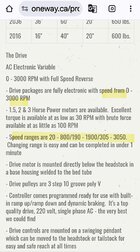
In one line the speed range is represented as 0-3000rpm, verifying what @Kevin Jesequel said. 2 lines down it shows the individual pulley speed ranges, with the lowest range of 20-800rpm. If zero was the true lowest speed, zero would be shown as the low speed on every pulley step combination. If that were truly the case, the middle pulley combo would probably be were I have the belt most of the time.
Yeah, a phone call should verify.

If zero was the true lowest speed, zero would be shown as the low speed on every pulley step combination.
No Oneway here, but my suspicion is the zero "speed" is correct but the wording is misleading, at zero the speed knob is just turned all the way down and lathe is just not spinning! If that's right, ALL my lathes have a 0-xxx range!
I have told this story before, but now one more time.... When I got my 3520A, the turn off speed was 10 or so rpm. This was 25 or so years ago. When they made the B model, the shut off speed was 50 rpm. I called to ask them why. The response was some thing like "your motor will over head and you will fry your electronics". I told them that I had sanded out thousands of bowls at those speeds and had no problems. Note here, I once turn my bowls and the more they warp, the more I like them, and you can not keep an abrasive on the wood at more than 15 or so rpm. They said some thing like, "oh no, we have run tests in our labs and you will overheat your motor and fry your electronics". Major eye roll for me. I got a very early Robust American Beauty to replace the PM. A really early version with 3 speeds, which I think all lathes should have. I called Brent up and asked about programming it to run slower so I could sand my warped bowls. He cautioned me about the motor over heating, and to keep checking it for overheating. Well, it turns out that the motor runs cooler when sanding than it does when I turn. I should mention that I make my lathe WORK when I turn bowls. As near as I can tell, the only load on the motor when sanding is braking. I sand with my angle drill in reverse, which just works for me. I now have a Vicmark 240 which has a pivoting headstock so I don't have to lean over or extend my arms. As it comes, the speed will go down to 10 or so rpm, and it is a 3 speed range lathe. No clue as to where "your motor will overheat and you will fry your electronics" comes from. Pretty much all of the lathes are that way now. I guess that if I was putting a torque load on the lathe at very slow speeds, then the motor could overheat, but other than hand sanding and using too much hand pressure, I can't see that happening. I would say to call Oneway and tell them what you need that speed range for. They may tell you that your motor warranty will be voided. Most motors on lathes are TEFC (totally enclosed fan cooled), and I don't know if putting a fan on it would help or not.
robo hippy
robo hippy
Nothing says you can't make a DIY larger version or just a larger boxThat's an interesting piece of apparatus, but it wouldn't work for me in most situations; the sizes of most of my HFs would exceed the dimensions of that device.
None of this low rpm problem talk was ever discussed in the days of DC motor and controllers. I've had 3 Vicmarc lathes (VL300, 200, and the discontinued baby 100), with new Leeson DC motors and Minarik AC-DC converter/controllers, and all ran happily from dead standstill to top speed, never an issue. My habit was to "stop" the lathe by turning the dial to zero. I used it as a safety feature, too, ramping the up and down from zero rpm. The wood never went from stop back to whatever the previous speed was.
The motor will cut out due to overheating at the lowest speed after a few minutes. There is no fan for cooling it at those speeds. There are lots of ideas out there for rigs using a bar b q rotisserie drive either driving the lathe spindle or something directly driven by the low geared motor.
I'll give Oneway a call next week, to see if I can find out what the lowest speed it will run at without over heating.The motor will cut out due to overheating at the lowest speed after a few minutes.
I run my 2436 on the lowest speed all the time for doing poly finishes. There isn't any issue doing it.
- Joined
- Nov 27, 2021
- Messages
- 232
- Likes
- 974
- Location
- Silver Spring, MD
- Website
- www.transpirationturning.com
All this low speed talk made me spend a few hours programming this as a feature for the LatheEngraver. I'll add it as a simple dial to the UI in the future. Continuous rotation from 1-30 RPMs.
@Steve Chaplin - thanks
My Oneway 1640 will run about 5 minutes but certainly not much more than 10 before it shuts down (I've never really stood there and timed it). Once it shuts down, it won't restart right away unless I unplug it so it has a chance to reset itself.The motor will cut out due to overheating at the lowest speed after a few minutes.
I opened up my 2436 control box today to see what I could see in this regard. Below 6 hz the inverter or motor would growl a bit and cut out after a minute or two, requiring a reset. Going by the website figure of 800 rpm in low range, that suggests a minimum practical speed of 80 rpm. I spoke to Shane at Oneway to see if that could be lowered and he said no.
Interestingly, the 2000 series webpage states "Speed ranges are 20 - 800/190 - 1900/305 - 3050". The minimums on the upper ranges are 10% of the maximums but not for low range, so what's up with that?
More recent units than mine (1998) may have a different minimum speed. In any case I really don't have a problem with a minimum of 80, but I am not trying to use the lathe for preventing curtaining of thick finish coats.
Interestingly, the 2000 series webpage states "Speed ranges are 20 - 800/190 - 1900/305 - 3050". The minimums on the upper ranges are 10% of the maximums but not for low range, so what's up with that?
More recent units than mine (1998) may have a different minimum speed. In any case I really don't have a problem with a minimum of 80, but I am not trying to use the lathe for preventing curtaining of thick finish coats.
Last edited:
Robo, I also have the Robust AB with a 3 step pully. Can't remember when I got it, somewhere around 2019-2010 I would guess. Was a welcome upgrade from the great white one I had before that. Anyway after 3 or four yrs of using it and switching belts from pully to pully I asked Bret if it was possible to alter its speed somewhat so I could just leave it on the middle pully. He said yes but also explained the limits of such and the issues of doing that. What I wanted was a slightly slower speed for sanding, and a slightly higher speed for turning faster at times.
Not sure how much we turned the low speed down, maybe 15% or so, and increased the high speed apx 10%.
I never sand with much pressure and rarely turn at full speed, usually at about 75-85% of max. Anyway, that was about ten yrs ago and my lathe works good as new. I have not changed it off the center pully since.
It's a fantastic lathe and worth every penny and more that I paid for it. Not just in its pure performance and abilities, but also just the pure pleasure of using it. The same cannot be said about the great white one that I had nothing but problems with prior to purchasing my Robust.
Not sure how much we turned the low speed down, maybe 15% or so, and increased the high speed apx 10%.
I never sand with much pressure and rarely turn at full speed, usually at about 75-85% of max. Anyway, that was about ten yrs ago and my lathe works good as new. I have not changed it off the center pully since.
It's a fantastic lathe and worth every penny and more that I paid for it. Not just in its pure performance and abilities, but also just the pure pleasure of using it. The same cannot be said about the great white one that I had nothing but problems with prior to purchasing my Robust.
I found this thread via the search function.
I've been concerned about the heat generated in the motor of my JET 16-42 when I leave it running at 51 rpms for extended periods of time.
I do it to let resin and finishes dry.
It doesn't get so hot you can't touch it, but it's quite warm.
I figured a muffin fan mounted over the grill might help.
I took it apart to look today, and behind the fan is a plate that prohibits any airflow through the motor.
See the attached photos.
There's an airspace around the grill that allows air to blow down the outside of the motor casing but no way to blow through the motor inside.
It's also sealed inside the headstock.
Am I missing something here?
I mounted the muffin fan anyways as I had it apart.
Craig
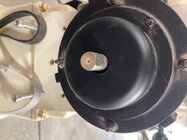

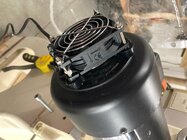
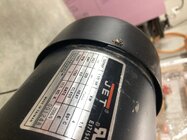
I've been concerned about the heat generated in the motor of my JET 16-42 when I leave it running at 51 rpms for extended periods of time.
I do it to let resin and finishes dry.
It doesn't get so hot you can't touch it, but it's quite warm.
I figured a muffin fan mounted over the grill might help.
I took it apart to look today, and behind the fan is a plate that prohibits any airflow through the motor.
See the attached photos.
There's an airspace around the grill that allows air to blow down the outside of the motor casing but no way to blow through the motor inside.
It's also sealed inside the headstock.
Am I missing something here?
I mounted the muffin fan anyways as I had it apart.
Craig




I've never taken apart a motor on one of my Jet 1642 lathes, but I believe it's a TEFC (totally enclosed fan cooled motor), made that way to protect it from dust. When using one of mine for long periods it would bet pretty warm but never hot, not too warm. I now use a Powermatic 3520b and it has a similar motor but with more power. (All these motors are 3-phase, the phase conversion done by the VFDs.) I wouldn't worry about it much - I believe these motors are made to take it..
However, if you want to go a different route, some people make a slow turner just for finishes. One way is to use a cheap rotisserie motor and make a mount. There are other ways too. Search for "slow turner for lathe finishes" and you should find a lot of info including youtube videos.
(I don't know if any of this was already covered in the thread.)
JKJ
However, if you want to go a different route, some people make a slow turner just for finishes. One way is to use a cheap rotisserie motor and make a mount. There are other ways too. Search for "slow turner for lathe finishes" and you should find a lot of info including youtube videos.
(I don't know if any of this was already covered in the thread.)
JKJ
John is correct on the TEFC, you do not want external air internal to the motor. Cooling is provided by passing air air over the surface of the motor. The shroud over the OEM fan helps by directing air over the surface. At low RPM the fan, which as you discovered, is shaft mounted so it is not moving much air. Your add-on fan is fine and will provide additionally cooling.I found this thread via the search function.
I've been concerned about the heat generated in the motor of my JET 16-42 when I leave it running at 51 rpms for extended periods of time.
I do it to let resin and finishes dry.
It doesn't get so hot you can't touch it, but it's quite warm.
I figured a muffin fan mounted over the grill might help.
I took it apart to look today, and behind the fan is a plate that prohibits any airflow through the motor.
See the attached photos.
There's an airspace around the grill that allows air to blow down the outside of the motor casing but no way to blow through the motor inside.
It's also sealed inside the headstock.
Am I missing something here?
I mounted the muffin fan anyways as I had it apart.
Craig
View attachment 80728View attachment 80729View attachment 80730View attachment 80731
Per the nameplate on your motor it is likely fine even without the added cooling as the windings are rated for internal temperatures in the range of 250-260 degrees f. The surface will be cooler than that. If you can spit on the outside of the motor and it doesn’t bubble and start boiling, you are good!
Over time thermal cycle will cause degradation, but that takes a while if you stay in its limits. As said, you added cooling is fine and you should be in good shape if you can touch the outside without needing to pull your hand away.
Thanks for taking the time to reply.
Seems like kind of an in-efficient way to cool a motor, but it's better than having sawdust clogging up the inside.
It was squeaky clean and dust free inside.
We use a flexible aluminum heat sink material at the shop to cool the intake plumbing on some high end turbo / supercharged cars.
Maybe I'll wrap some of that around the motor, can't hurt right?
Craig
Seems like kind of an in-efficient way to cool a motor, but it's better than having sawdust clogging up the inside.
It was squeaky clean and dust free inside.
We use a flexible aluminum heat sink material at the shop to cool the intake plumbing on some high end turbo / supercharged cars.
Maybe I'll wrap some of that around the motor, can't hurt right?
Craig
Many TEFC motors have fins to promote cooling. Two things you need to think about:Thanks for taking the time to reply.
Seems like kind of an in-efficient way to cool a motor, but it's better than having sawdust clogging up the inside.
It was squeaky clean and dust free inside.
We use a flexible aluminum heat sink material at the shop to cool the intake plumbing on some high end turbo / supercharged cars.
Maybe I'll wrap some of that around the motor, can't hurt right?
Craig
- if attaching the fins blocks the flow of air from the shroud on the end you will affect the cooling air flow. That means you need to make up for with air to air from the fins themselves, BUT…
- fins can gather sawdust now reducing cooling efficiency. Just put the fins on the bottom? Uneven cooling could introduce some vibration.
Things to think about. Be careful not to over improve. We have all done it before.
Craig, just checking, but does your muffin fan block air flow when the motor is running at higher RPM?
Hi Mike,
I was thinking about how to accurately answer your question and hit on the idea of measuring wind speed over the motor.
I dug my wind meter out of my shooting box and it would measure the air flow.
At it's lowest setting which is 51rpm.
1.1mph without the fan.
3.5 with the fan
Highest rpm using the low speed pulleys is 1280 rpm
Air speed was 19.7 without the fan and 22.1 with it
See the attached pics.
The little fan does seem to keep the motor somewhat cooler to the touch.
Mark, 46 years as a German auto mechanic and shop owner taught me that you can never over improve a motor

We won't talk about my thoughts of wrapping it with copper tubing and using liquid cooling.
Sometimes I think I could over engineer an anvil.
Craig
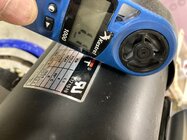
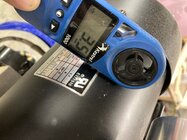
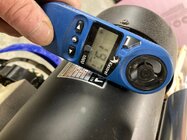
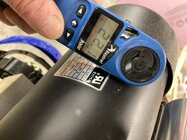
I was thinking about how to accurately answer your question and hit on the idea of measuring wind speed over the motor.
I dug my wind meter out of my shooting box and it would measure the air flow.
At it's lowest setting which is 51rpm.
1.1mph without the fan.
3.5 with the fan
Highest rpm using the low speed pulleys is 1280 rpm
Air speed was 19.7 without the fan and 22.1 with it
See the attached pics.
The little fan does seem to keep the motor somewhat cooler to the touch.
Mark, 46 years as a German auto mechanic and shop owner taught me that you can never over improve a motor
We won't talk about my thoughts of wrapping it with copper tubing and using liquid cooling.
Sometimes I think I could over engineer an anvil.
Craig




